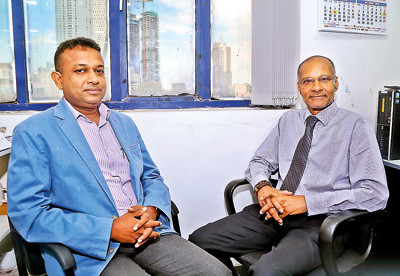News
Govt. Analyst Department not sufficiently equipped: Many killings, mysterious deaths go unsolved
Many cases of killings and suicide in Sri Lanka are going unsolved because of the need for sophisticated equipment to determine the cause of death, two senior forensic experts have said.

Prof. Sarathchandra Kodikara and Dr. Colin Seneviratne
Dr. Colin Seneviratne, a toxicologist from the United Kingdom, and Prof. Sarathchandra Kodikara, a pathologist and the Head of Peradeniya University’s Forensic Medicine Faculty, have said Sri Lanka should have modern toxicology testing equipment to solve mysterious deaths.
Dr. Kodikara said that in Sri Lanka there had been several deaths that had gone unsolved due to the lack of intricate and sophisticated toxicology equipment.
“When death becomes suspicious it is important that a proper forensic investigation be made to determine the cause of death. In a country which has no sophisticated equipment several deaths can go unsolved and murderers can go free,” he said.
Also in cases of an overdose of a drug, it was important to determine the particular drug and its contents to establish the cause of death.
Suspicious deaths also could be determined by using sophisticated equipment.
A student of the late Prof. C.J. Babapulle, Dr. Seneviratne who is on a holiday in Sri Lanka said that in a country where illicit drugs had become a menace, upgrading the government Toxicological Department was important.
He said drug peddlers and dealers often sold drugs mixed with cutting agents to enhance the effect of the drugs. These cutting agents could lead to death. In such cases the sophisticated equipment could be useful in determining the cause of death.
Dr. Seneviratne said that in the United Kingdom, sophisticated equipment, that could perform blanket screening on more than 800 people, was being used to determine cutting agents.
When a death was sudden and had taken place outside a hospital, the coroner was called upon to do a post-mortem examination. The coroner according to available evidence inquired into the sudden death.
The pathologist — armed with the dead person’s medical history, social history, ante-mortem tests, circumstances of death and reports of laboratory tests done on the patient — opened up the body to find the cause of death. When the naked eye failed to detect evidence of the cause of the death, scientific investigation was done and forensic pathogens were called upon to determine the cause.
If the cause of a death could not be determined by a pathologist the body was sent to a toxicologist for examination. For a toxicologist classical toxicology specimens of blood, urine and vitreous fluid from the eyes were important to carry out the autopsy.
Dr. Seneviratne said that death was a process that happened slowly and body fluids could be taken from a body within 72 hours. During post-mortem examinations blood was taken from the femoral vein, urine from the bladder or vitreous fluid from the eyes. In a decomposed body, tissues were taken from skeletal muscles or from the maggots that had infested the body.
He said it was important that the body be kept under refrigeration to slow down putrefaction. In a dead person, the bowels normally got putrefied early, while the muscle and bone tissue lasted longer.
Forensic histopathology was done where tissue samples were stained, processed and looked under a microscope for evidence. In forensic toxicology evidence was looked for in the urine samples. The investigation would reveal drug abuse, if any. He said blood samples were also used to investigate for medication and illicit drugs. Most often the cutting agent in illicit drugs could be the cause of death. To determine the cutting agent Sri Lanka needed more experts with analytical skills and facilities.
Explaining this further, he said a stimulant such as Amphetamine which increased the activity of the chemicals of the brain when used alone was not harmful. But the result could be different when mixed with the animal anaesthetic carfentanil, which was a powerful opiod, ten times more powerful than morphine.
He said the Government Analyst Department was not sufficiently equipped to determine cause of death. It could determine only common drugs.

